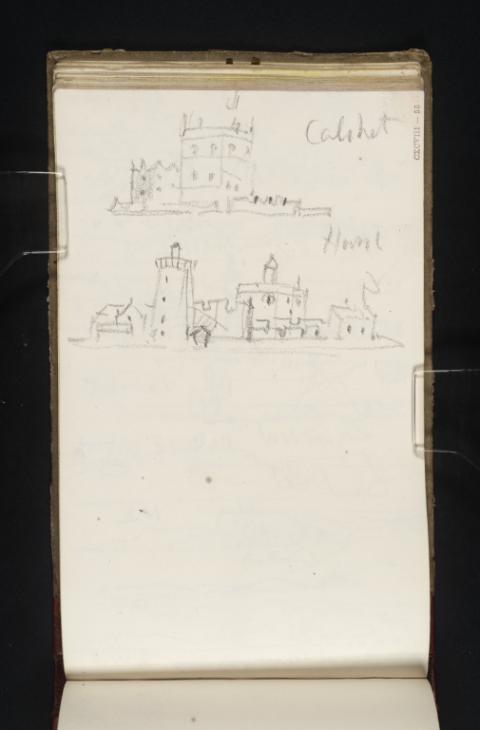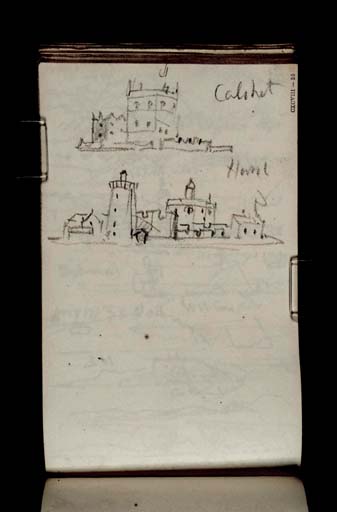Joseph Mallord William Turner Calshot Castle and Hurst Castle c.1821-2
Image 1 of 2
Joseph Mallord William Turner,
Calshot Castle and Hurst Castle
c.1821-2
Joseph Mallord William Turner 1775–1851
Folio 55 Recto:
Calshot Castle and Hurst Castle c.1821–2
D17296
Turner Bequest CXCVIII 55
Turner Bequest CXCVIII 55
Pencil on white wove paper, 187 x 113 mm
Inscribed by Turner in pencil ‘Calshot’ top right, and ‘Hurst’ towards top right
Inscribed by John Ruskin in red ink ‘55’ top right, ascending vertically
Stamped in black ‘CXCVIII – 55’ top right, ascending vertically
Inscribed by Turner in pencil ‘Calshot’ top right, and ‘Hurst’ towards top right
Inscribed by John Ruskin in red ink ‘55’ top right, ascending vertically
Stamped in black ‘CXCVIII – 55’ top right, ascending vertically
Accepted by the nation as part of the Turner Bequest 1856
References
1909
A.J. Finberg, A Complete Inventory of the Drawings of the Turner Bequest, London 1909, vol.I, p.605, CXCVIII 55, as ‘“Calshot” Castle and “Hurst” Castle’.
As deciphered by Finberg, the two sure-handed and precise drawings on this vertically orientated page demonstrate coastal artillery forts on the Hampshire coast: Calshot Castle and Hurst Castle.1 Turner has annotated each one accordingly with a clear inscription.
In a move repeated across several of the following pages (folios 55 verso, 56 recto, 56 verso, and 57 recto; D17297–D17300) and also occupying a later section of the sketchbook (folios 77 verso, 78 verso, 79 recto, and 80 verso; D17388, D17340–D17341, and D17344) Turner has copied each of these compositions from The Little Sea Torch, an illustrated maritime text by Richard Bougard, translated from the French by J.T. Serres and published in London in 1801.2 For more detailed information about the publication, and an interrogation of Turner’s use of it, see the sketchbook Introduction. Both drawings on this page are taken from engravings on Plate 15. Calshot Castle is numbered 6 on the printed page, and titled ‘Calshot Castle at the entrance of Southampton River’.3 Hurst Castle is illustration number 7.4
At the top of the page is the former of the two landmarks. Built by Henry VIII in 1539 as part of his maritime defence programme,5 Calshot Castle was one of a vast number of coastal fortifications instated along the south coast of England in anticipation of French or Spanish invasion.6 It was manned consistently for over four hundred years as a functioning military base.7
Turner makes his drawing of Calshot Castle with a thick, soft or perhaps blunt pencil. The lines are neat and considered. In a direct emulation of the illustration in The Little Sea Torch, a shadow is cast across half of the smaller building on the left and windows in both structures are marked. Turner even briefly describes the flag hoisted on a pole affixed to the structure in the original illustration, although he omits surface decoration completely.
Below this is a copy of Hurst Castle. Another of Henry VIII’s artillery forts, it was the most advanced of its kind at the time of construction and was completed in 1544.8 Also in Hampshire, it defends the western approach to the Solent. In 1648 Charles I was imprisoned there before his trial and execution in London. During the Napoleonic wars the design was modernised, and in 1870s armoured wings were added.9
Like the drawing above, the handling is soft and blunt; thick, straight lines carefully meet to produce a considered record of the various walls and windows, as well as the low-flying flag towards the right, as delineated in the engraving from The Little Sea Torch.
Maud Whatley
January 2016
Richard Bougard, The Little Sea Torch: or, True Guide for Coasting Pilots: by which they are clearly instructed how to navigate along the coasts of Malta, Corsica, Sardinia, and others in the Straits; and of The Coast of Barbary, from Cape Bon to Cape de Verd, trans. with corrections and additions by John Thomas Serres, London 1801. For an online and PDF facsimile, see ‘The Little Sea Torch’, Biblioteca Nacional de Portugal, accessed 26 October 2015, http://purl.pt/23500 .
‘Plate 15’, The Little Sea Torch, accessed 12 November 2015, http://purl.pt/23500/1/index.html#/179/html .
‘Calshot Castle: a 16th century artillery castle’, Historic England, accessed 12 November 2015, http://www.historicengland.org.uk/listing/the-list/list-entry/1014619 .
‘Calshot Castle’, Hampshire County Council, accessed 12 November 2015, http://www3.hants.gov.uk/calshot-castle.htm .
‘Hurst Castle’, English Heritage, accessed 12 November 2015, http://www.english-heritage.org.uk/visit/places/hurst-castle/ .
How to cite
Maud Whatley, ‘Calshot Castle and Hurst Castle c.1821–2 by Joseph Mallord William Turner’, catalogue entry, January 2016, in David Blayney Brown (ed.), J.M.W. Turner: Sketchbooks, Drawings and Watercolours, Tate Research Publication, February 2017, https://www


